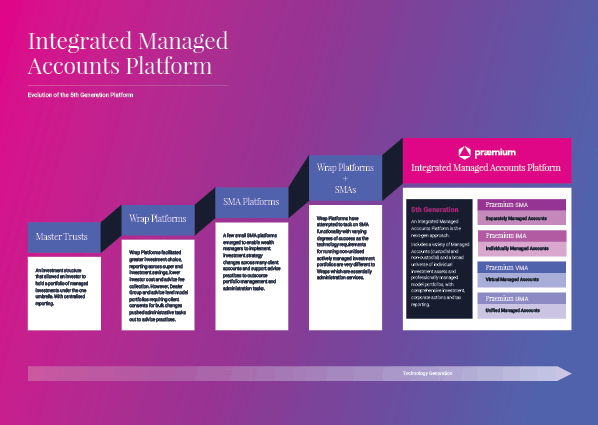The next generation investment platform
Promoted by Praemium.
Not all platforms are the same. So what makes a platform truly next generation and how can this give investors and advisers a better experience?

The greatest transfer of wealth in the history of mankind has begun. In the next three decades, $30 trillion in assets will move from one generation to the next in the US alone. In Australia, the transfer is estimated to be well over $3 trillion, and worldwide the figures are staggering.
In our digital, constantly on, 24/7-access world, this new generation of asset holders will see wealth creation through very different eyes. The old way of doing things won’t cut it anymore. The tried and tested ‘Buy the banks and BHP’ strategy, twice-yearly client meetings and annual portfolio updates simply won’t satisfy. They will expect more. Much more.
When seeking financial advice, investors want more focus on setting and meeting their individual goals, and for their investments, they expect more transparency of holdings and fees, simple solutions tailored to their financial plan, and access to more engaging reporting, 24/7.
But none of this is news. The seismic shifts in our industry are no secret.
Where we are now
FoFA and the Royal Commission have shown us that some investors are not having a great advice or investment experience, especially ‘fees for no service’, which may help explain why 80% of Australians currently do not use or intend to use a financial adviser and 90% change advisers when they receive an inheritance. This is a real challenge for the advice industry, and this challenge presents itself again when advisers and their clients choose an investment platform to help execute their plans. The problem they face in choosing a platform becomes, not fees for no service, but rather fees for limited efficiencies.
For advice businesses to feel confident in recommending an investment platform to their clients, they need as a minimum: simple and consolidated reporting of all investment assets; broad investment choice with ease and flexibility to make changes; tailored solutions and benefits for every kind of investor they advise; administrative accuracy and efficiency; and the benefit of very competitive fees at all levels reducing over time with increasing platform scale.
Unfortunately, adviser and client expectations often go unmet.
- Reporting: Many wrap platforms are unable to provide comprehensive, deep and transparent reporting on listed securities.
- Brokerage: Some charge expensive, minimum flat-dollar-based brokerage with scale efficiencies not passed onto clients.
- Alternatively, platforms that have tacked on SMAs alongside their investment menu of managed funds and listed investments typically charge more than 10 bps for brokerage on trades within SMA model portfolios. This can prove very expensive for active management given the ongoing volume of transactions.
- These platforms also typically do not share benefits of scale from netting of trades across their total FUM. If they do provide a netting benefit, most often it is only at the investor or account level.
- Cash rate: When funds are held in cash, many platforms are delivering a cash rate that is considerably less than the RBA rate.
- Choice: Due to manual or old rebalancing technology or other system restrictions, some platforms have a limited choice of SMA model portfolios.
- Flexibility: Some platforms offer a limited range of managed investment options with little access to listed investments, minimal transparency and no flexibility to in-specie transfer assets due to their wholesale bundled mandate structures.
- Holistic view: In nearly all cases advisers and their clients are struggling to achieve a consolidated view where they have multiple family members or structures and investment assets that straddle custody and non-custody. Advice businesses are also often limited in being able to provide relevant tailored solutions to all client segments on the same platform.
How we got here
The platform landscape has changed significantly over the past 25 years. In the early 1990s we saw the development of Master Trusts as the first platform structure to consolidate investment execution and reporting and simplify the investment experience for investors and their advisers.
Next came wrap platforms, which facilitated broader investment choice (e.g. listed securities), broader overarching reporting across super and ordinary investment savings, lower investor costs, greater advice fee collection functionality and the introduction of adviser- and dealer-level model portfolio functionality.
While well intended, model portfolio functionality on wrap platforms started to push administrative tasks out to advice businesses, negating some of the key efficiencies and time savings that were provided in the first instance. One of the biggest offenders was the need to gain individual client consents for bulk investment changes.
In response, for predominantly high-net-worth investors we saw the emergence of Managed Discretionary Accounts (MDAs) sitting over regulated wrap platforms (i.e. Limited MDA). Unfortunately, however, the adviser and investor experience were arguably no more efficient, and in recent times the regulator introduced a plan to phase this structure out.
Concurrently with Limited MDAs, Praemium and then a few small Separately Managed Account (SMA) platforms emerged to enable the outsourcing of portfolio management and administration tasks by advice businesses. SMAs, and managed accounts more broadly, have since become one of the fastest growing investment solutions in financial services.
Because of this growing popularity, many wrap platforms have, with varying degrees of success, attempted to tack on SMAs and associated functionality. This has been a difficult undertaking for some since the technology requirements for running non-unitised, actively managed investment portfolios are fundamentally different to wraps, which are essentially investment administration services.

The evolution of platforms
Where we’re going
The fundamental shift to managed accounts has been well documented by Investment Trends, Morgan Stanley and others. Indications are that more than two-thirds of advisers now use managed accounts or intend to use them in the near future, and managed accounts are capturing a high percentage of new industry FUM flows. Advisers and investors are recognising the inherent investment, transparency and cost benefits for investors and efficiency gains for advice businesses.
But unfortunately, all managed accounts platforms are not the same. Ensuring that investors and their advisers are having a great investment experience requires a truly next-generation investment platform.
A next-gen integrated Managed Accounts platform includes simple and consolidated reporting of all investment assets (including custody and non-custody); broad investment choice with ease and flexibility to make changes; tailored solutions for every kind of investor; administrative accuracy and efficiency; and the benefit of platform scale in the form of very competitive fees at all levels.
Forget fees for limited efficiencies. A great Managed Accounts platform provides the height of efficiency for advice businesses, plus value, transparency and scale economies for investors.
For the past 18 months Praemium has been working on a program of client engagement that has translated into a major upgrade to our leading integrated Managed Accounts platform. Praemium is the next generation in platform technology.
Welcome to the Upgrade.
Find out about how our next generation platform could support your business.
Subscribe to 
Never miss the stories that impact the industry.





